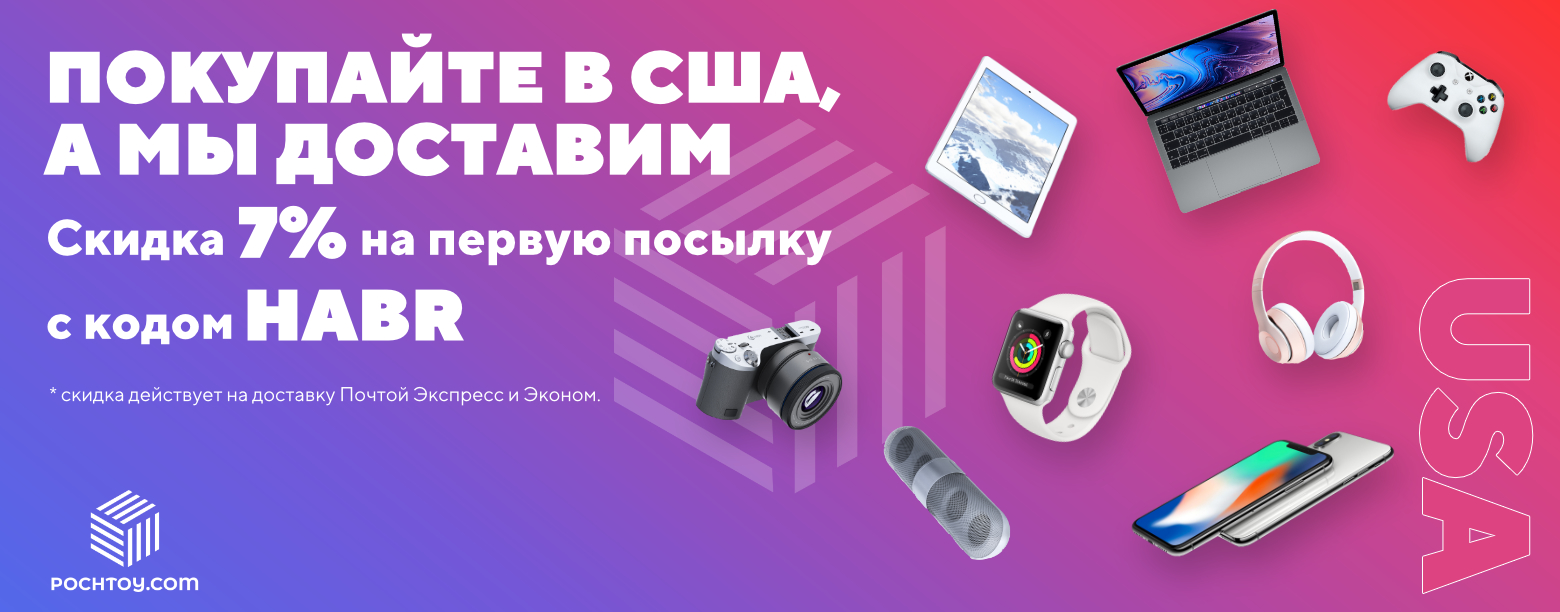The strength of the crowd. How Chicago developed a rubbish robot - a river cleaner
- Transfer

If you walk along the banks of the Chicago River this summer, you will see something rather unusual. Among the ducks, swans, fish, rare beavers and otters, a small robot will swim from time to time. Similar to a small raft, he will lazily walk down and up the river, collecting everything that appears on its surface. This Thrashbot is the brainchild of Chicago-based startup Urban Rivers, which brought together environmentalists, robotics, and other professionals to clean up city rivers of garbage and help their inhabitants.
In appearance, the Thrashbot may seem like a “water rumba”, autonomously (or accidentally) choosing a path, while there is still pollution ahead. He moves on his own, just like a rumba! But in fact the opposite is true. The robot does not choose a direction for itself, at any time it can be controlled by one of approximately 4,383,810,342 people - global Internet users.
Everyone with internet access can log in to the Urban Rivers website and become a bot pilot for two minutes. The goal of the company is for a person to find garbage at this time and grab it, and ideally also to take it to a special container near the river bank, from where it will be removed later. So the cleansing of the rivers becomes not a virtual activity, which "someone is engaged somewhere", but a very real occupation in which you can physically participate - while not polluting your hands.
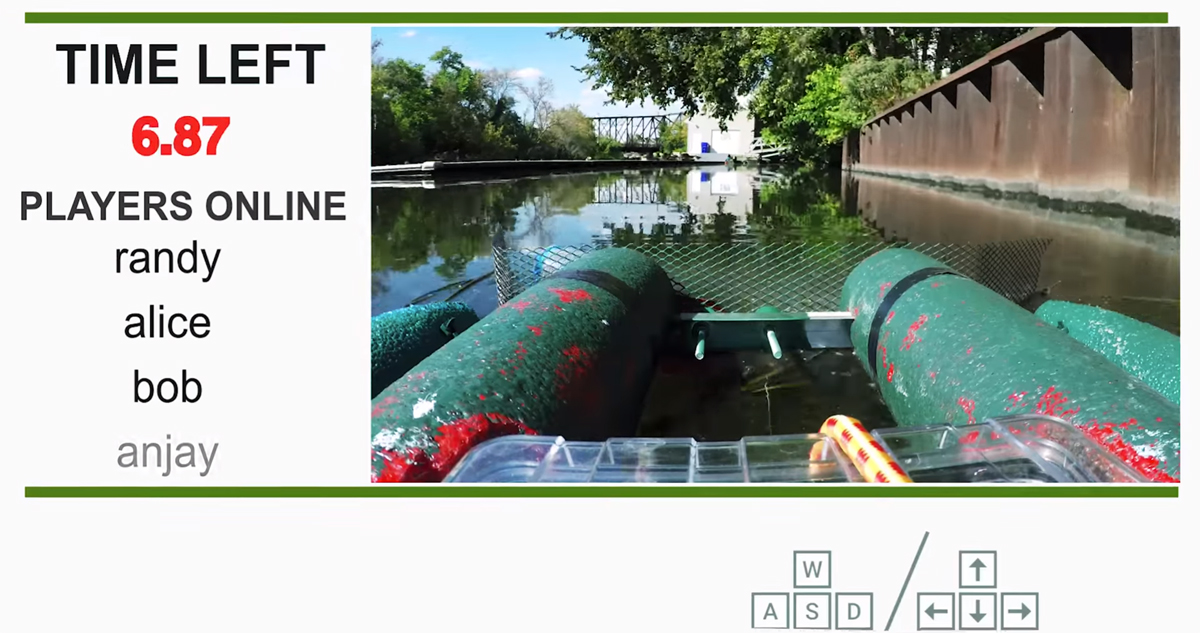
Nick Wesley, one of the project managers, says:
We are finally at the stage when most people live in places with a decent Internet connection. The technology required to build our robot is no more complicated than the technology in an inexpensive drone. You can stream a video with a fairly small delay, and at such speeds it can be controlled. The benefit to nature, interesting for a couple of minutes, gives the feeling that today you have done something useful, what else is needed.
Thrashbot Construction
The idea of developing managed waste bins to clean up city rivers appeared two years ago. In June 2017, Urban Rivers successfully created “ floating gardens ” on the same Chicago River to help animals return to their natural habitat. Unfortunately, the team realized that these gardens were quickly littered with garbage. To solve the problem, they began to invite volunteers who, as usual, went to the river in the morning and manually collected more or less large litter. Efficiency was very low, mainly due to the irregular flow of the river.

Sometimes people went to shore in the morning, and there was no garbage to collect. Then something changed over the course, and soon this place was filled with garbage. We realized that here we need a solution that will be included constantly. So that the garbage is cleaned in real time, as it goes with the flow.
The beginnings of an idea appeared, but the team did not know how to make the robot find and collect contaminants. Computer vision and image recognition technologies have progressed well in recent years, but to teach the bot to determine what fits the concept of “garbage” was still not easy. Garbage is a pretty abstract concept. It turned out that so far only people can separate it from natural objects in the river. And so the idea of creating a remotely controlled “rumba” was formed, which could be piloted by users from all over the world.

The launch of the first Thrashbot is scheduled for the end of this month, and it will begin to work stably in June. Then you can try to personally pilot it. In the meantime, the most impatient users can practice an online demo in a test pool (or, as it is pompously called here, an “underground aqua laboratory”) filled with plastic ducks that need to be collected. Each is given five minutes. And this, by the way, is really quite fun.
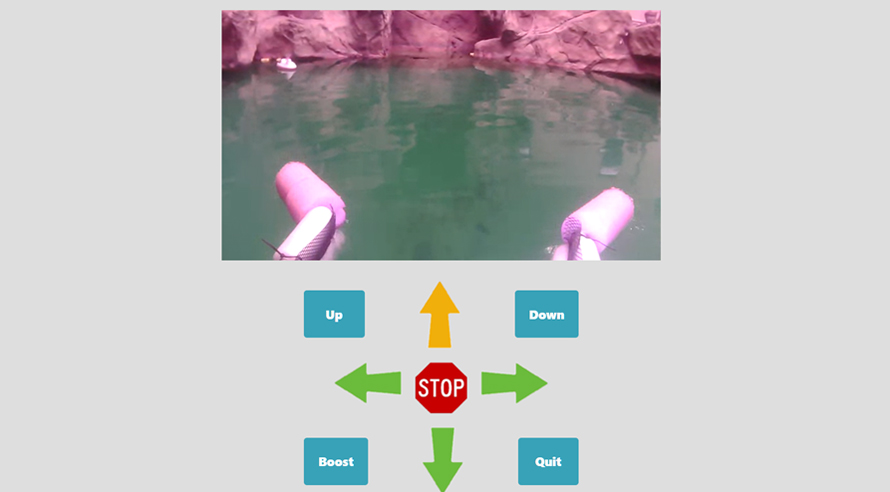
Even from Russia, the robot responds quite quickly, it is easy to control, although no assembled ducks were found (due to the Habra effect, it may take a little longer to wait for its turn to the robot).
Crowd strength
The idea of asking the public for help to solve big problems is by no means a new one. In 1715, the mathematician and astronomer Edmund Halley (after whom Halley's comet was named) published a map predicting the time and path of future solar eclipses. Since Halley could only be in one physical place during the eclipse, he issued a “request to the curious” and asked them to capture their location and how the sky looked during the eclipse, asking especially to note the “duration of total darkness”. This first crowdsourcing was successful, and collecting information from the public, Halley created a second, even more accurate map, which helped predict the eclipse in 1724.

Halley Eclipse Map
Today, technology makes it possible to add real interactivity to Halley's methods. People can be involved not only in the processes of collecting and transmitting information. People can do more interesting and varied work, thus getting something in return from the process. In 1991, almost 300 years after Halley's initiative, Lauren Carpenter, co-founder of Pixar Studios, made a catchy demo broadcast at a computer graphics conference. He first showed the participants the power of the crowd, and demonstrated that each member of the audience can be used as a separate node to solve the problem.
The “problem” was getting 5000 conference participants to play one giant ping-pong game. Each present was given a racket, with one green and one red side. In the center of the room was a large screen, like in a movie theater, that showed a classic video game, and a computer that scanned the audience and found out which side of the racket they were holding up - red or green. Each racket held by a member of the audience was counted as one vote (step up or step down), and the virtual ball hit on the screen passed according to the law of such democracy. An upgraded version of this experiment in 2013 was also conducted by the BBC.. The movement of the ball (or, in this case, the shark) is rather slow, and it’s not very interesting to observe, but being in the audience and trying to work as a whole to achieve the common goal is quite.
Loren Carpenter experiment on SIGGRAPH-91
The Internet takes this kind of work with the crowd, and takes it to a new level. Now you can connect to the task not a couple of hundred people, like Halley, and not 5000 people, like Carpenter, but any number, even millions. Such massive collaboration led to the emergence of Wikipedia, Linux, and even the giant hyperlink PageRank , which led to the emergence of Google. Clearing the rivers with the help of crowd power should also become something quite achievable. And this is far from the only problem that can be solved in this way.
Salvation with Zooniverse
Chris Lintott is professor of astrophysics at the University of Oxford. Twelve years ago, he worked on a project for which he needed to analyze the shape of galaxies. But, even if you take a small piece of space, there are too many galaxies - many millions. It turned out that, as in the case with the definition of debris on the Chicago River, the human eye with the classification of the type of galaxy so far copes better than a machine. After classifying 50,000 galaxies, Lintott and the team decided that they needed help.
We created a website, Galaxy Zoo, and asked the public - ordinary users - to help us determine the type of galaxies. You did not need to know what a galaxy is, or to have an interest in astronomy. You just saw what was in front of you in the image, and you chose what it looked more like. People showed great interest in the site, we received hundreds of millions of classifications.
As a result, everyone got a chance to become part of advanced space discoveries. One Danish teacher, Hanni van Arkel, even discovered an incomprehensible object - she was given something on the site that looked like a green figure, she consulted the forum if this was a mistake, enthusiasts checked this part of the cosmos, and there really seemed something strange . Now this object (most likely, an accumulation of gas, highlighted by a quasar) in honor of the teacher is called the “ Hanni Object ”.
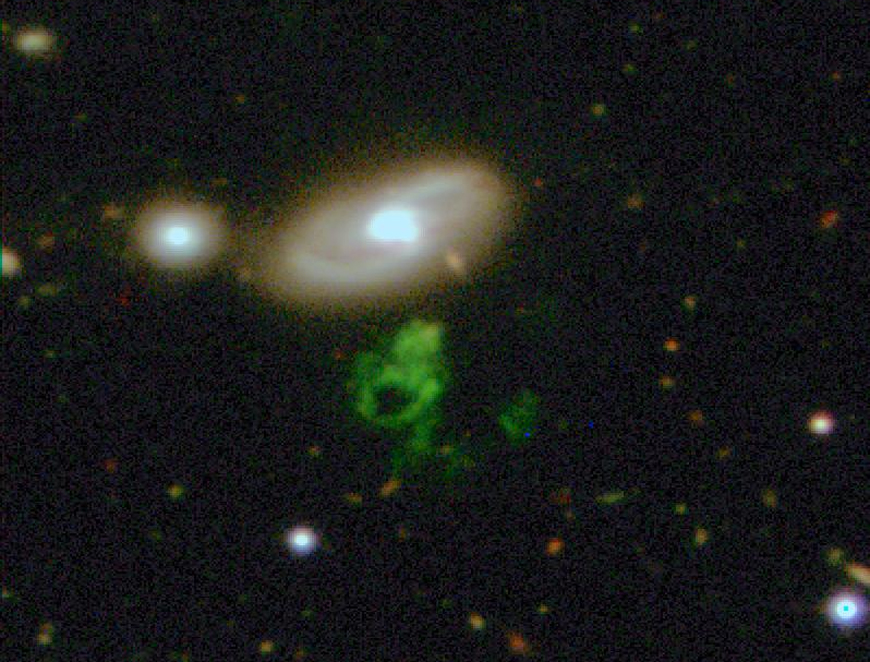
Well, for Chris Lintott, the main thing was that the project was incredibly successful:
Other researchers began to contact us, who simply could not cope with the volume of their data. From astronomy to biomedicine and sociology, everyone needed to process them somehow.
So Lintott created something like “Kickstarter” for research - the Zooniverse platform , where scientists can crowdsource projects by asking for help from the public. About a hundred projects are working on it, just too large for a limited number of scientists.
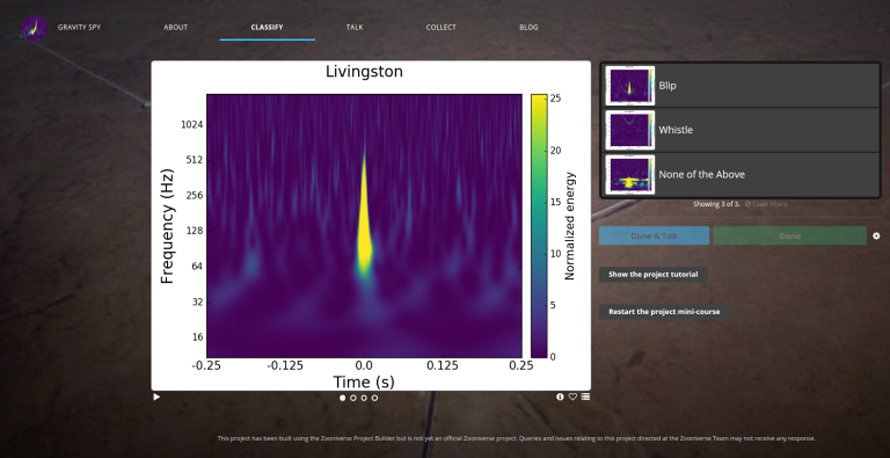
Gravity spy
One such project, Gravity Spy , helps astrophysicists identify gravitational waves and separate them from errors in data collected by laser interferometers. Ordinary users currently have more than 1.2 million classifications. Another project, Wild Gabon , estimates the mammal population in the African savannah. And Planet Hunters invites people to discover new planets using data from NASA satellites. So far, there are about a hundred of them so open (out of 300 thousand verified images).
Chris Lintott, founder of Zooniverse, says:
It’s even hard for me to imagine that 20 years ago no one discovered a single planet around other stars. Now you can do this simply with your web browser.
When Hurricane Irma walked through the Caribbean islands in 2017, the Planetary Response Network used the Zooniverse to create the most accurate maps of the area. Almost six thousand volunteers walked through 300 thousand images to determine which roads were flooded, which were blocked, and which others could still be moved. Refugee groups in need of immediate assistance were also reported there. It turned out to be a great and indispensable tool for humanitarian workers arriving in the region.
The triumph of communities?
Crowdsourcing is not a panacea, of course. It will not always be the answer to global problems. A solution cannot always be decentralized and turned into a game for the public, like picking up trash with a robot or discovering new planets. In the book by Evgeny Morozov “To save everything, click here”, the growing faith in people is criticized that any situation can be solved by one fix.

But, as Thrashbot and dozens of projects on Zooniverse confirm, even the most ambitious problems can at least be greatly simplified. Especially if they follow one formula: a large, centralized task that can be divided into small-small pieces. In general, it is ideal if each of these pieces represents some kind of small completed work that you can feel. It’s like raising one plastic bag from a river, adding a separate edit to Wikipedia, or checking the image for a planet or galaxy in it.
Lintott explains:
Their actions must be real and meaningful. You cannot just let people fill out forms. They must feel part of an important process. If you can achieve this, you will see that many people are ready to make very great efforts.
The emergence and development of new technologies, such as VR and drones, opens up new prospects, so this rather unusual section of crowdsourcing in the near future may become even more interesting. Ordinary users can help not only in filling out maps, piloting robots, or finding the right objects in images. For example, on the Internet it is theoretically possible to sense (and, accordingly, classify) sounds, tastes , smells and textures .

Такие общие краудсорс-проекты, как Zooniverse и Трэшбот, вовлекают обычных пользователей в важные процессы – даже если они происходят за тысячи километров от них. И это однозначно лучше тренда на «кликтивизм» (как активизм, но только в виде кликов) – когда люди считают, что сделали очень полезную вещь, просто потому, что они лайкнули нужную страничку или пост на «Фейсбуке». Как и кликтивизм, инициативы вроде Gravity Spy или Planet Hunters позволяют вам участвовать в процессе, оставаясь в халатике и не покидая комфорта собственного кресла. Но здесь есть реальная и мгновенная польза, плюс вы все-таки прикладываете хоть немного усилий.
Ник Уэсли, один из создателей Трэшбота в Urban Rivers, объясняет:
I think these new technologies of remote presence and involvement are an extremely useful tool that allows people to gain experience in something that may not be in their place of residence. When you find something or explore something yourself, you become more interested in it. I think this is really cool. There are many different areas that can use this approach to solve really big global problems. Especially if you can gamify this process and make it truly interactive.
PS Buying in the USA is profitable with Pochtoy.com. Delivery with us - from $ 11.99 per pound. By the way, until May 26, we buy products from Amazon for free.
